
Dan Lago
Draft 1-18-2024
Introduction
The “Mountainman” was first offered by Queen in 1976 and did not have a great reception. Fred Fisher and I have an article about that first edition knife on our website mountainman-8-19.pdf (queencutleryguide.com), so we will not cover the same ground in this long article.
However, the knife was resurrected by Queen in 2002 in its 100-year anniversary set – Smooth Buffalo Horn with Mother of Pearl Keystone shield, traditional clip blade as the “Lockback Hunter” (Model # 14113L 3L (Figure 1). In 2003, the original name reappeared as the “Mountain Man folding Lockback Hunter” (Figure 2). That knife has remained very consistent with a 4.1/2” frame and 3.5/8” clip blade, for a total length of nearly 8 ¼ inches. Almost all blades show the same flat grind on every d2 steel blade, though we will point out a few exceptions in each photo. All these knives were bareheaded, with a small interior piece and lanyard hole to strengthen the cap end. Some have thinner handles, but many have wide handles and provide a great grip – they are a heavy use knife.
In 2004, they added a second blade to the frame and named it “Mountain Man Trapper folding Outers Knife with large clip and skinner blades,” (Model #04213T). While they have made more of this big trapper, the basic lockback hunter has been one of Queen’s best sellers since it was reintroduced. This article will only cover the locking version of the Mountain Man (3L). Further, although the frame for the Mountain Man was used many times for the Express switchblade, we will also not cover that knife, since our website contains detailed coverage of that series with five different articles based on blade types (See references).
Queen Cutlery added the Mountain Man knife to their catalog line in the locking version (3L) in 2004, in two handle materials, (Carved stag bone [CSB] and Cocobolo [COBO] as a wood version). Based on comments, they then released the non-locking version (#3) in 2007. Model-3-10-2019.pdf (queencutleryguide.com). You can see in the catalog summary Guide, that the Model number #3 was used from 1947 until 1981, and had not been used for 22 years. Queen seems never to have settled on the correct spelling of the name; The locking version was called “Mountain Man,” while the non-locking version was “Mountainman,” So, perhaps the lock was marketed as a bit more “manly.”

Figure 1. The sales flyer for the 2002 Schatt & Morgan 100 Anniversary set in polished buffalo horn with pearl shield, in an edition of 1000. Many collectors feel this was the single best set for the Annual Schatt & Morgan series. The first issue of the revised Mountain Man and using a gold blade etch. This knife was in 420 stainless steel with mirror polish.

Figure 2. The 2003, Mountain Man in “Golden Age jigged Bone, with a sterling silver keystone shield and mirror polished 420 Stainless steel blade. The first time the annual edition size dropped to 600.
Queen Cutlery Catalog Versions of the Mountain Man
Queen produced eleven different versions of the Mountain Man between 2002 and 2017, including the Annual Keystone knives shown above. All but one used D2 tool steel. Because these photo show two knives taken with a very close camera and perspective, the upper knife may seem smaller, but they are all the same size. The reference section shows a link to check the duration of offering each of these versions. Queen never offered numbers of each version produced.

Figure 3. Initial catalog offering of the Mountain Man 3L, with the lower knife in Carved Stag Bone (CSB) and the upper knife in Cocobolo (COBO). Always a wood and bone option. Both knives show the round “relief” shield.

Figure 4. Aged Honey Amber Carved Stag Bone (ACSB), below, and Birdseye Maple (BEM) wood handle on top. One can see these early versions all carry the “relief” round shield. The ACSB was very popular and was offered for more years than any other catalog knife version – It will be easier to find but might also have a slight premium in price.

Figure 5. Olive Drab Linen Micarta (LM), below, and African Curley Zebra (CZ) wood, top, around 2013. Both knives now carry the “incised” round shield. The Daniels family LM is the only time the company used a saber grind on this knife, making the blade a bit stronger and a bit better as “wedging apart” when cutting thicker material. With the thicker micarta handle, and tool steel, this knife is built for heavier use than most Queen knives in this pattern.

Figure 6. Page 25, from the Queen Catalog of 2016, showing #3L in “Feathered Buffalo Horn (FBH), with transverse grooves, “jimping” on top of the blade to improve grip for more precise cuts. This image makes the horn look almost black- when usually it is seen with paler streak patterns in the horn.
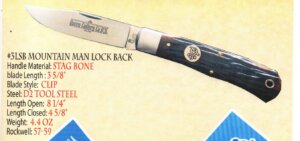
Figure 7. Page 17, from 2017 Queen Cutlery Catalog, showing “Stag Bone” in #3L Mountain Man. Note the jimping is no longer seen at the top of the blade; probably a cost cutting move in the company’s last year of making knives. Earlier years of the SB will have the jimping and be easier to obtain.

Figure 8. Page 31, from the 2017, Queen last Catalog, showing a #3L(WH) “Work Horse,” a cost-reduced knife with carbon steel blades and Delrin plastic “imitation bone” handles that was meant for EDC, everyday carry. If, found, the Delrin handles could be quite variable by company choice.
The last three Mountain man catalog knives are not easy to find (Figures 6-8). The last two catalogs were not printed and distributed widely, but were largely viewed on the Internet site and many people might not even have known of their availability. The company was heavily engaged using the remaining smaller work force in making and selling special project knives like the “rooster” cock-fighting knives or the new “Express switchblades” that could sell for higher prices. They simply did not produce many of these knives and there were consistent access issues to catalog knives. I have never seen a #3L “Work Horse Mountain Man.” It is still a little sad to look back at these catalogs.
Queen Cutlery Special Projects and Special Factory Orders of the Mountain Man #3L.
The Mountain Man was very popular and many different versions were produced often without dates or sponsors unless the blade etch had information. Many photos are from public Internet sites, so relatively little is known about them. We offer them only to provide some evidence of the knives’ existence. It is very likely this listing will be incomplete, based only on our scanning Internet sales sites for six years (when it might usually take 20 -25 years for knives to reappear out of private collections). If you own a Mountain Man and do not see it among these knives, please consider sending us a good photo so it can be added to future editions of this listing. Thank you. Thirty seven special projects are listed in this section.

Figure 9. 3L smooth Buffalo horn with pearl shield 2002 based on the 100-year anniversary S & M, but no etch as an “overrun” of the main set (top). There was also a version of this knife with a gray/silver blade etch. This was a VERY popular knife with the first ever pearl shield. The bottom knife is later, maybe around 2015, by Daniels Family Cutlery using a black Micarta handle and but continuing the use of the pearl shield in 1-50, harkening back to an earlier success and using up inventory.
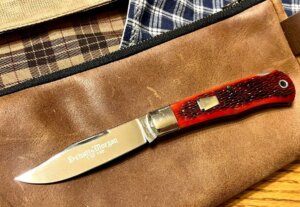
Figure 10. A jigged Red bone Schatt & Morgan knife in 1-100 edition. No date. (public Internet photo).

Figure 11. An Allegheny Mountain Knife Collector Association 2004, annual knife. A group local to Titusville got in early to have a torched Sambar stag version made with a flag-oriented of their initials and the bear shield they used on many knives. This is a beautiful knife IMO in a very small edition.

Figure 12. A Mountain Man with National knife Collectors Association (NKCA) with their extra shield and a Keystone shield in a brown bone worm grooved treatment usually used at that time for File & Wire knives by Queen. This knife was probably produced in usually small edition for this Museum opening, but the exact size is not known. (public Internet photo).

Figure 13. A Queen Collector Club Mountain Man for 2010 with Ebony wood handles and incised shield, in an edition of 1-50.

Figure 14. A Moore Maker Mountain Man in Rams Horn The pile side has a round unmarked shield for engraving and the Moore Maker shield on the mark side. The Rams Horn is thick and polished. This knife was made by Queen many times for Moore maker and I saw it being made several times in annual factory tours. This one shows 2014 date on the pile side. The steel is not shown, but it is probably 420 stainless for the mirror polish. Again, a very attractive knife.

Figure 15. #3L, blond bone in File and Wire treatment. Often this F & W were made with ATS 34, but we do not know what steel was used in this knife. (Public Internet Photo).

Figure 16. #3L S & M a rarely seen multicolored bone, 1-100. (public Internet photo). Blade seems mirror polished and so might be 420 Stainless steel? Notice the shallow jimping on this blade. (public Internet photo).

Figure 17. # 3L SFO, Bill Swan, Cumberland knife works, brown stag bone Hard to read in this photo, but etch clearly shows, 1095 carbon Steel and an ususual type face for the name. This knife shows the earlier round “relief” shield and one of the first uses of jimping by Queen on the back of the blade, with 15 deep cuts. There was also a version of this knife in torched Sambar stag in a much smaller edition. (public Internet photo).

Figure 18. A #3L SFO from the Badger Knife Club in a light brown worm grooved bone, with a custom red, round shield of the club on the pile side. The steel used is not shown, but it probably 420 stainless even though in File and Wire series on the tang. The blade shows a substantial sedge along the top of the blade, small jimping at the back, and a nice three color etch – all expensive items to add to the knife in a 2005 edition. A nice example of how a sponsor could get exactly what they wanted if they would pay. (public Internet photo).
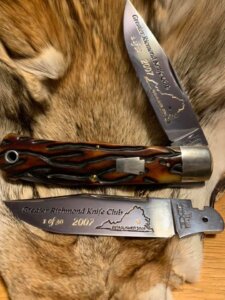
Figure 19. #3L Greater Richmond Knife Club, 1-30, 2007 brown worm grooved bone with Keystone and Schatt & Morgan tang stamp. Again, a very nice deep multi-color etch for the club, with an extra blade. (public Internet photo).

Figure 20. A #3L that seems to be in line with several file & Wire versions (Figures 12, and 18) and showing the swedge – like Figure 18 in brown worm grooved bone, and probably 420 stainless, though not shown. This knife was likely an “overrun” of some of the above SFO knives.

Figure 21. #3L Robeson ShurEdge version in American Walnut. The knife shows a light strike on the tang stamp, an oval Robeson shield, and very strangely, patterned brass on the liners (not used till the Daniels era), though with a box and label that would have been characteristic of the first decade of the 2000s. Robesons were usually made in editions of 200 and with bone covers, but this knife might have been made in a smaller edition. The existence of a Robeson ShurEdge-etched blade could also mean other Robeson Mountain Man knives might still be found.(public Internet photo).

Figure 22. A #3L File & Wire, Torched Sambar Stag, with patterned brass liners. This series of knives was produced by Daniels Family Cutlery era by Queen, as a special project in fairly small editions of 300, using patterned brass in stock from the series of “executive” or “Paladins” in 1998-2003. Those were very thin knives, and were not much a commercial success, but using the patterned brass as liners in these big knives was very attractive and they were fitted with massive handles, and shallow jimping that made these knives great to handle. (public Internet photo).
These are hard knives to find today and IMO were the nicest Mountain Man locking knives Queen ever produced. The sales flyer announcing them had four versions listed, but has been lost! And there is no other documentation. Again, always some mystery in collecting Queen. The following Figures 23-25, show two additional versions.

Figure 23. Somewhat hard to see, but you can get a glimpse into the patterned brass of these two Mountain Man knives. This photo also shows the shallow jimping much better than the others covering this set.
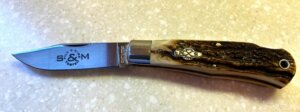
Figure 24. A #3L Mountain Man Elk Stag in File & Wire with patterned brass liners in an edition of 300. Notice the width of this stag handle.

Figure 25. A#3L File & Wire, Smooth White Bone with patterned brass liners in an edition of 300 from 2013. (public Internet photo). There is a fourth knife in this set but I have no details about its’ handle treatment.
The last few Mountain Man knives shown are from the last years of Queen Cutlery and are harder for collectors to find and might shown somewhat less attention to finishing and unusual details, including more carbon steel blades and smaller editions. In these last years there many be other Mountain Man knives that will eventually show up out of collections. Some might also be “parts knives” finished after the factory closed in January 10th, 2018, since many parts and supplies were sold at the bankruptcy auction. Some of these knives might be very well made, depending on the skill of the maker. Any buyer makes personal choices to pick knives that he or she feels should be in their collection. We cover this issue in an article on our website: Parts-Knives-after-the-Queen-Bankruptcy-3-2020.pdf (queencutleryguide.com).

Figure 26. A #3L with Blue Shockwood covers and no shield. This handle material was used by Daniels Family in its last few years, 2015-17, and the available material was a little short for the frame, which is why this knife has a cap end bolster – very rare for this #3L pattern. The steel used in this knife is not known, nor the size of the edition, though probably quite small. (Public Internet photo).

Figure 27. #3L in a “glow in the dark” acrylic handle, with Schatt & Morgan Blade and no shield. The steel used is not known, but the blade does show the deep jimping suggesting made in approximately 2015-16. While the blade etch says “edition of 1 of 10”, the Internet seller who listed this piece claimed only one was produced? (Public Internet photo).

Figure 28. #3L Desert ironwood with a Schatt & Morgan blade with no shield. This cover wood was frequently used in the Daniels era, again suggesting 2015-16. The steel in this knife or the edition size are not known. (Public Internet photo).
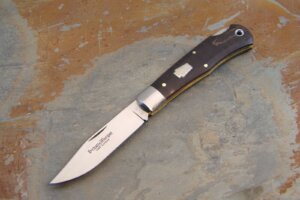
Figure 29. #3L Dark Curly Maple with Schatt & Morgan etch and tang with Keystone shield. Carbon Steel is shown in the blade etch. This Curly Maple cover has almost a matte finish and was used in many Daniels era knives No edition size is provided, but probably not a large size. (Public Internet Photo).

Figure 30. A #3L with Schatt & Morgan blade etched “prototype” and keystone shield (maybe pearl or nickel silver?) with black Micarta handles. The blade shows similar jimping to the 2013 File & Wire knives (Figures 22-25) and is flat ground. (Public Internet Photo).
This knife and several below might be part of the Q-TAC series of more modern “tactical” lockbacks Queen Cutlery developed during the Daniel Family era from 2013-2015 in catalog knives and sales flyers. As advertised, they used G-10 handles, ATS steel, thumb studs, special tang stamp, belt hook, and lanyards installed. They also were advertised as using stainless steel backsprings, pinning material and belt hooks – a decided step up. Usually, the ATS34 was shown on the blade up near the nail nick or thumb stud and some were also shown with D2 steel. All these features were clearly designed to upgrade the Mountain Man to compete with other tactical folding knives. We do not know how they fared in the market place, but their absence in the last two catalogs suggests they were not heavily supported by Queen Collectors who preferred very traditional style knives. Several are pictured in Figures 30-33. though not all show all features, but they are included in this review because they all show micarta covers which were previously not used in the Mountain Man, suggesting the Daniels Family era.

Figure 31. #3L with a very smooth, deep amber micarta cover with a Queen round incised shield and a D2 steel blade that shows a “prototype” etch and saber grind. This blade might have been consistent with the Olive Drab linen Micarta Queen introduced in 2013 (figure 5), using up inventory, so it is the only saber grind seen in this pattern in its’ 15 year-run. It is also possible that Queen was working on how to get back from a pure “Q-TAC” model to a little more “traditional” Mountain Man, with a higher level of finish. This is a rare knife in our experience – having seen only one in five years. (Fred & Linda Fisher Photograph).

Figure 32. A #3L Q-TAC in pink micarta (offered only in 2015), with thumb stud with large “easy open” cut on the handles, heavy jimping on the back of the blade, lanyard, and serrated cutting section of the blade; which was never mentioned in Queen sales literature. It might show the process of developing a new knife by Queen or might have been added by a buyer. The fact that this knife has pins that are ground flat to the surface, compared to spun pins (see Figure 31) also suggest that this has been worked over. The knife does show the Q-TAC tang stamp and the factory style paracord lanyard. (Public Internet Photo).

Figure 33. A #3L Q-TAC in “Coyote brown” micarta showing all features mentioned in Queen sales literature, especially the ATS34 etch just in front of the thumb stud, the paracord lanyard, and the QTAC tang stamp. Notice the smaller easy open cut on this knife compared to Figure 32 – many little differences in the Q-TAC knives if you get to study them as a group. (Public Internet Photo).
The final Queen-made Mountain Man knives are all SFO’s customized from Yellowhorse Cutlery, either David Yellowhorse or Brian Yellowhorse. Again, we know relatively little about these knives and have not examined them in person, due to limited editions and the critical fact that they are generally above our price point! Some of these are beautiful knives!

Figure 34. #3L Showing “Yellowhorse” tang stamp and a brown and orange “swirl” acrylic cover. This knife does not show some of the additional custom elements of the following Yellowhorse knives and might be part of some early collaborations with Micheal Prater who has specialized in some modern acrylic covers on other Queen knives.

Figure 35. An unusual customization of a #3L , showing Queen relief shield, tang stamp, and a dark green jigged bone handle used frequently in later Queen knives, with an unusual and attractive blade etch, but with a frequently seen bolster. The producer’s name is “Wild Horse customs” but little is known about this knife. So, until we learn more, I have put it tentatively in a Yellowhorse grouping. (Public Internet Photo).

Figure 36. A #3L with a carbon steel blade cut to look like chipped stone, with blue and white pearl and “spiney” minerals and “Eagle Mountain” shield in an edition of 1-10. (Public Internet Photo).

Figure 37. A #3L customized by David Yellowhorse with carbon steel “chipped” blade and minerals embedded in acrylic and shield “the polar bear.” Edition of 1-10. (Public Internet Photo).

Figure 38. A #3L customized by David Yellowhorse with carbon steel “chipped” blade and minerals embedded in acrylic and shield “the Fossilized Eagle”. Edition of 1-10. (Public Internet Photo).

Figure 39. A #3L customized by David Yellowhorse with carbon steel “chipped” blade and minerals embedded in acrylic and shield “the Morning Singer.” Edition of 1-10. (Public Internet Photo).

Figure 40. #3L customized by David Yellowhorse with carbon steel “chipped” blade and turquoise minerals embedded in acrylic and shield “the Howling wolf.” Edition of 1-10. (Public Internet Photo).
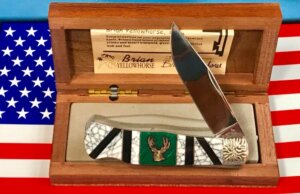
Figure 41. A #3L customized by Brian Yellowhorse with stainless steel with Yellowhorse tang stamp and minerals embedded in acrylic and shield “the whitetailed deer.” Edition size unknown. This knife is in a wooden box with enclosed certificate and with a style that characterizes early Yellowhorse knives, though there is no date nor edition size with the photo. (Public Internet Photo).
While this summary is quite long, it is a first edition of Queen Mountain Man #3L lockback knives. I am sure there are Mountain Man knives missed in this summary. If you have one you do not see here, please consider contacting us with a good photo and any information you think would improve this article. Thank you.
This knife has a relatively short history, but was very popular with collectors who liked large patterns and was one of Queen’s best sellers for its entire run as a catalog knife and as a special factory order knife. There were some complaints about blade wobble and strong lock-up in this knife in the later years and some concerns about parts knives after the factory closed, so it is reasonable to encourage handling a knife before a deal is completed, because you can expect to pay considerable for one of these large knives.
References.
Clip-Point-Mountain-Man-Express-Knives-by-Queen-Cutlery-2-16-22.pdf (queencutleryguide.com)
Wharncliff-Blade-Mountain-Man-Express-by-Queen-Cutlery-2-16-2022-1.pdf (queencutleryguide.com)
Special-3EXP-Damascus-and-Mammoth-by-Queen-Cutlery-2-16-22-first-edition.pdf (queencutleryguide.com)
Queen-Express-knives-database-2-16-22.pdf (queencutleryguide.com)
Model-3-10-2019.pdf (queencutleryguide.com). This page lists all catalog knives at the end under “3L”.
Executive-Paladin-10-2019.pdf (queencutleryguide.com)
Parts-Knives-after-the-Queen-Bankruptcy-3-2020.pdf (queencutleryguide.com)
Q-Tactical-10-2019.pdf (queencutleryguide.com)


